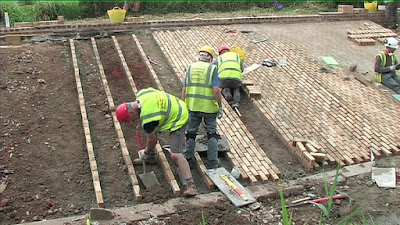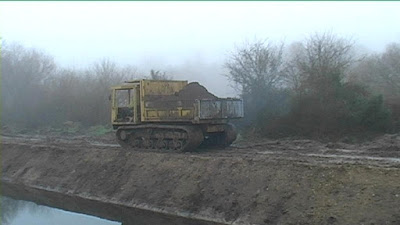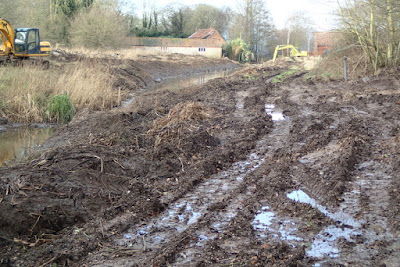The Water Gates
My Blogs are like buses, you wait ages for one and then two turn up together. As promised in my last blog here is more detail of the installation of the lock gates at Bacton Wood.
My Blogs are like buses, you wait ages for one and then two turn up together. As promised in my last blog here is more detail of the installation of the lock gates at Bacton Wood.
On a cold sunny day in February 2017 the
lower gates for the lock at Bacton Wood were lifted into place.
Dog walkers and ramblers watched as the enormous
structures were lifted into position in the entrance to the lock. But none of the spectators were aware of the effort it had taken to arrive at this final part of the project.
Work had started on the gates in August 2016. The material of choice was
Greenheart timber. A close grained timber from South America weighing in at around seventy pounds per cubic foot.
Greenheart is so dense it will not float. The major advantage of Greenheart is it’s resistance to most water-bourne parasites that attack and destroy softer timbers.
Greenheart timber. A close grained timber from South America weighing in at around seventy pounds per cubic foot.
Greenheart is so dense it will not float. The major advantage of Greenheart is it’s resistance to most water-bourne parasites that attack and destroy softer timbers.
Contructing the two gates would require a total of twenty Mortise
and Tennon
joints cut into the timber frames. Because of the density of the timber, completing
three or four Mortise joints in a day was considered good going. Splinters from Greenheart timber, commonly turn
septic due to toxins contained in this most durable of hard woods.
 |
| Greenheart splinters commonly turn septic. |
Because each upright weighs over half a ton, a hydraulic
lift was essential to manoeuvre them into position. The next task was to cut twenty tennons into the
lighter cross members.
These weighed a mere quarter of a ton each.
When all the joints had been completed the gates
were laid out on the workshop floor.
These weighed a mere quarter of a ton each.
 |
| Completed tennons |
Then each one in turn was checked by dry fitting them. Some were a perfect fit – while others needed some fine
adjustment.
Cargo straps were used to draw the components together and a pinch bar used to part them.
Cargo straps were used to draw the components together and a pinch bar used to part them.
As well as aligning all the timber components, tie
irons also had to be fitted before the gate could be assembled. Each joint was cleaned out with an airline. Then all the cross members and tie irons were
aligned ready for the final assembly.
A waterproof, polyurethane adhesive was applied to
each joint.
Once applied the glue would set within thirty minutes. Just thirty minutes to align and close all the joints with no second chance. Any mistakes or delays at this stage would have been disastrous. The physical effort needed to hastily draw all the joints together before the adhesive began to set was a really tough session.
 |
| Applying the adhesive. |
Once applied the glue would set within thirty minutes. Just thirty minutes to align and close all the joints with no second chance. Any mistakes or delays at this stage would have been disastrous. The physical effort needed to hastily draw all the joints together before the adhesive began to set was a really tough session.
January 22nd 2017 dawned cold and frosty.
A group of Trust volunteers had assembled to plank the gates. Tannalised Pine was cut to length and laid into position on the gates.
A group of Trust volunteers had assembled to plank the gates. Tannalised Pine was cut to length and laid into position on the gates.
When the planks were in place one hundred pilot
holes were drilled through the pine into the frame below.
The planks were then removed and stacked in order,while the pilot holes were drilled out to a suitable depth in
the frame.
 |
| Drilling pilot holes into the frames. |
 |
| Replacing the planks. |
This done, the planks were carefully replaced in the exact position from where they had been removed. When all the drilled holes were perfectly aligned, the planks were glued into position and screwed down.
Constructing the gates was only part of the project. A means to transport them had to be found. This was achieved by modifying the brute of an old
farm trailer.
On the coldest winter’s day of 2017,
the volunteers set about converting the trailer.
The conversion was a fairly low tech affair. In spite of the
trailer’s short comings it was perfect
for the job. What it lacked in style and elegance was more than compensated for in strength.
The gates weighing almost four tons each were lifted
onto the trailer and transported from the yard to the canal.
 |
| Converting the trailer. |
Saturday February 18th.
To lower the water level in the lock chamber a battery of pumps had been running every day for almost a week.
Intrepid volunteers donned their wellington boots, armed themselves with shovels and ventured into the lock chamber to remove
the mud and silt that the pumps couldn’t clear.
To lower the water level in the lock chamber a battery of pumps had been running every day for almost a week.
 |
| Pumping out the lock chamber. |
The sludge was loaded into the JCB bucket and lifted out of the chamber.
When operational, the bottom edge of the gates would
traverse over a recess in the floor of the lock. But the gates could not be lifted into place until
the recess had been cleared of water and silt.
Clearing the recess was taking longer than planned and the project was falling well behind schedule.
 |
| The project was falling behind schedule. |
Clearing the recess was taking longer than planned and the project was falling well behind schedule.
Eventually by late afternoon the first gate was
lifted into position and secured against the lock.
Sunday February 19th.
The pumps had been shut down overnight resulting in the
water level rising by about two feet in the lock chamber. Before the second lift could go ahead the
water would have to be pumped out.
The recess in the floor of the lock had become
submerged again. So the “bucket and chuck it” brigade was called into action yet again.
By midday the second lift was ready.
Like clockwork the massive gate was lifted, turned,
and lowered into the lock.













































